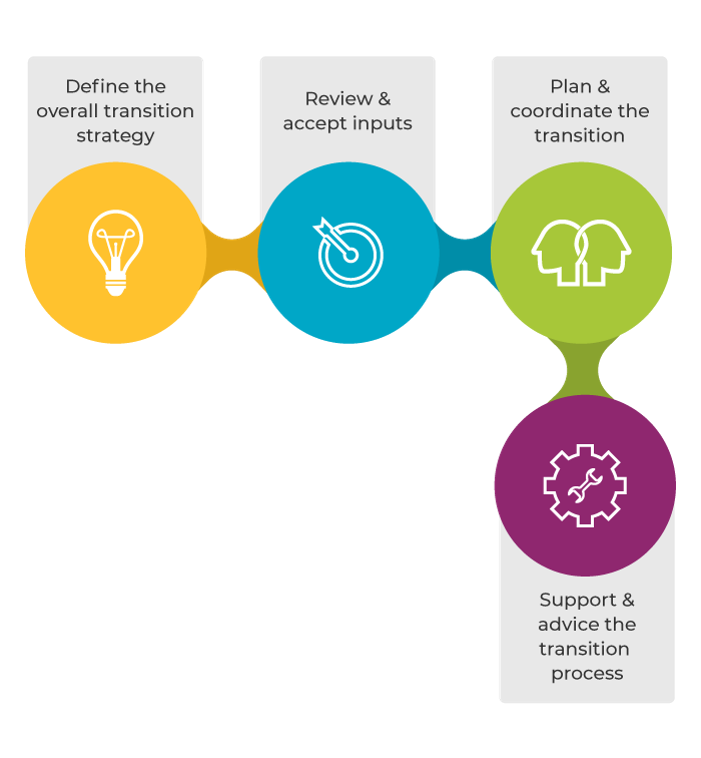
The role of ITIL Service Transition is to move services and service changes into operational use. ITIL Service Transition also introduces the service knowledge management system (SKMS) which has the ability to support organizational learning and assist in increasing the effectiveness and efficiency of all stages of the service life-cycle. This provides benefits to people with the knowledge and experience of others, helps to support decision-making, and improves the management of services. In this article, we will learn about the ITIL service transition, the objectives of ITIL service transition, and the various ITIL service transition processes.
What is ITIL Service Transition?
The main purpose of the service transition stage in the service life-cycle is to make sure that the new and modified or retired services meet the expectations of the business as previously agreed upon in the service strategy and service design stage of the ITIL lifecycle.
Objectives of ITIL Service Transition
The primary objectives of service transition are:
- Plan and manage the changes in service efficiently and effectively.
- Manage the risks related to newly introduced, modified, or discontinued services.
- Deploy the service releases into environments that support them adequately.
- Set the appropriate expectations for the performance and usage of new or changed services.
- Make sure that the service changes create the expected value for the business.
- Provide the necessary knowledge and information about services and service assets.
Scope of ITIL Service Transition
- The development and improvement of capabilities for the transitioning of new and modified services into the adequately supported environment, including the release, planning, development, analysis, and implementation, come under the scope of ITIL Service Transition.
- The retirement of service and the transfer of services between service providers is also considered.
Value to Business of ITIL Service Transition
The following benefits are provided by effective service transition:
- It provides us with a better estimation of the costs involved, the timing of the service, the resources required for implementation, and the risks involved.
- The volume of successful change brought about is higher.
- The objective is to aim to reduce the delays which occur as a result of unexpected clashes and dependencies.
- It results in a reduction of effort which is involved in managing test and pilot environments.
- It improves the expectation for all the stakeholders.
- Effective service transition also increases the confidence that a new or modified service can be delivered according to the mentioned specification without any unexpected change affecting other services and stakeholders.
- It ensures that the services which have been newly introduced or modified are easy to maintain and cost-effective in the long run.
- It also offers improved control of the different service assets and configurations.
Key Principles of ITIL Service Transition
The formal policies for service transition need to be clearly defined before implementation. Some of the formal policies are:
- Implementation of all the necessary changes to services through service transition.
- Adopt a common framework and set of standards for the processes.
- Establishing controls and disciplines which are effective.
- To provide systems for transferring knowledge and support decisions.
- To plan the package releases.
- Anticipation and management of the necessary course corrections.
- Make sure that the established processes and systems are re-used to the maximum extent.
- The service transition plans and business plans need to be aligned with each other.
- Establishing and maintaining relationships with the stakeholders involved.
- To manage the available resources across the service handles proactively.
- Ensure that there is involvement early on in the service life-cycle.
- To provide assurance of the quality of the newly introduced or modified service.
- Improve the quality of the service proactively during service transition.
ITIL Service Transition Process
The important activities for transition planning and support in the ITIL service transition process are:
- To define the complete strategy for transitioning including the policies, roles and responsibilities, standards, frameworks, and the criteria for success.
- Make the necessary preparations for service transition along with the review and acceptance of inputs, raising a request for making changes, checking the readiness for transition, and baselining the configuration.
- Plan and coordinate the transition of services which includes the generation of plans for service transition, reviewing and coordination of plans which are ready for release and deployment.
- To provide adequate support for the transitioning process which includes providing advice and assisting in administration, monitoring of progress, and reporting.
Challenges in ITIL Service Transition
The Challenges in ITIL Service Transition are:
- To build the necessary relationships which are required to handle and coordinate the several stakeholders who are a part of the service transition.
- To coordinate and prioritize the multiple services which have been introduced newly or modified recently, especially if there have been delays or failures of tests.
Risks in ITIL Service Transition
The Risks in ITIL Service Transition are:
- If the relationship between the project and program teams is not proper, it can result in service transition requirements that are totally unexpected.
- A lack of required information from the demand and service portfolio management results in reactive transition planning and support with inadequate long-term planning.
- If there is a delay to one transition, then it will have an effect even on future transitions as well.
- When there are conflicting requirements, insufficient information hinders their prioritization.
Conclusion
ITIL Service Transition thus helps to plan and manage the changes in service efficiently and effectively. By managing the risks related to newly introduced, modified, or discontinued services helps in deploying the service releases into environments. Give yourself a chance to grow in your Service Management career with the ITIL 4 Foundation certification training, and gain useful skills and best practices.
Know more about Service Management best practices through Invensis Learning’s IT Service Management certification training on ITIL 4 Course Online, SIAM Foundation, SIAM professional, VeriSM, etc.















